Low-Cost Carriers & Customer Satisfaction: A Study of Easy Jet Airways
VerifiedAdded on 2024/06/25
|35
|6230
|145
Report
AI Summary
This research report investigates the influence of low-cost carriers (LCCs) on customer satisfaction, specifically focusing on Easy Jet Airways. The study aims to understand how LCCs impact passenger satisfaction levels within the airline industry. The research identifies key dimensions of customer satisfaction, such as responsiveness and tangibles, and explores how these dimensions influence customer purchase intentions and word-of-mouth referrals. Through a mixed-methods approach, including surveys and literature review, the study analyzes the factors contributing to customer satisfaction in the context of low-cost air travel. The findings highlight the importance of low fares and service quality in shaping customer perceptions and driving satisfaction within the airline industry, offering insights for airlines seeking to enhance their competitive advantage.
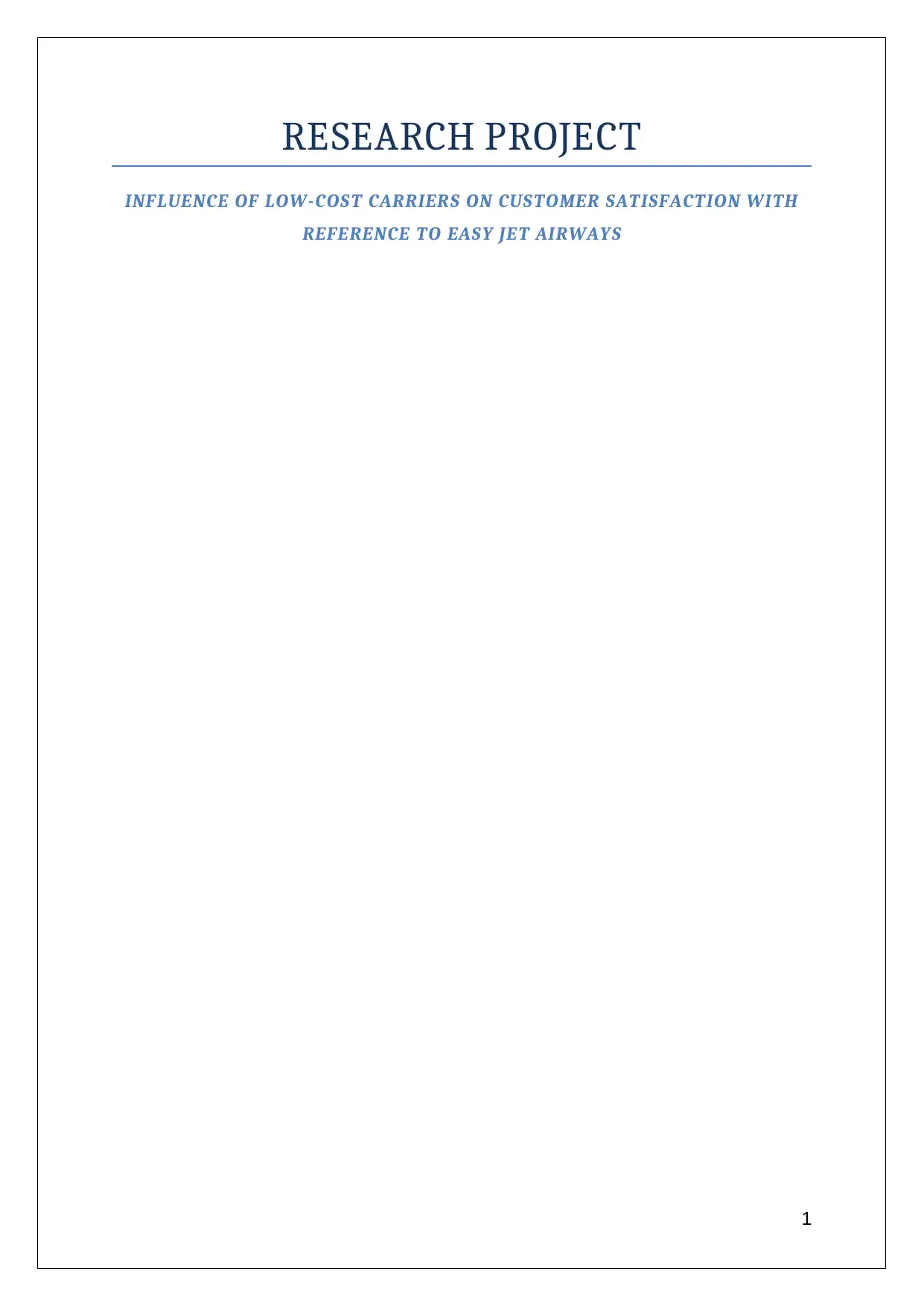
RESEARCH PROJECT
INFLUENCE OF LOW-COST CARRIERS ON CUSTOMER SATISFACTION WITH
REFERENCE TO EASY JET AIRWAYS
1
INFLUENCE OF LOW-COST CARRIERS ON CUSTOMER SATISFACTION WITH
REFERENCE TO EASY JET AIRWAYS
1
Paraphrase This Document
Need a fresh take? Get an instant paraphrase of this document with our AI Paraphraser
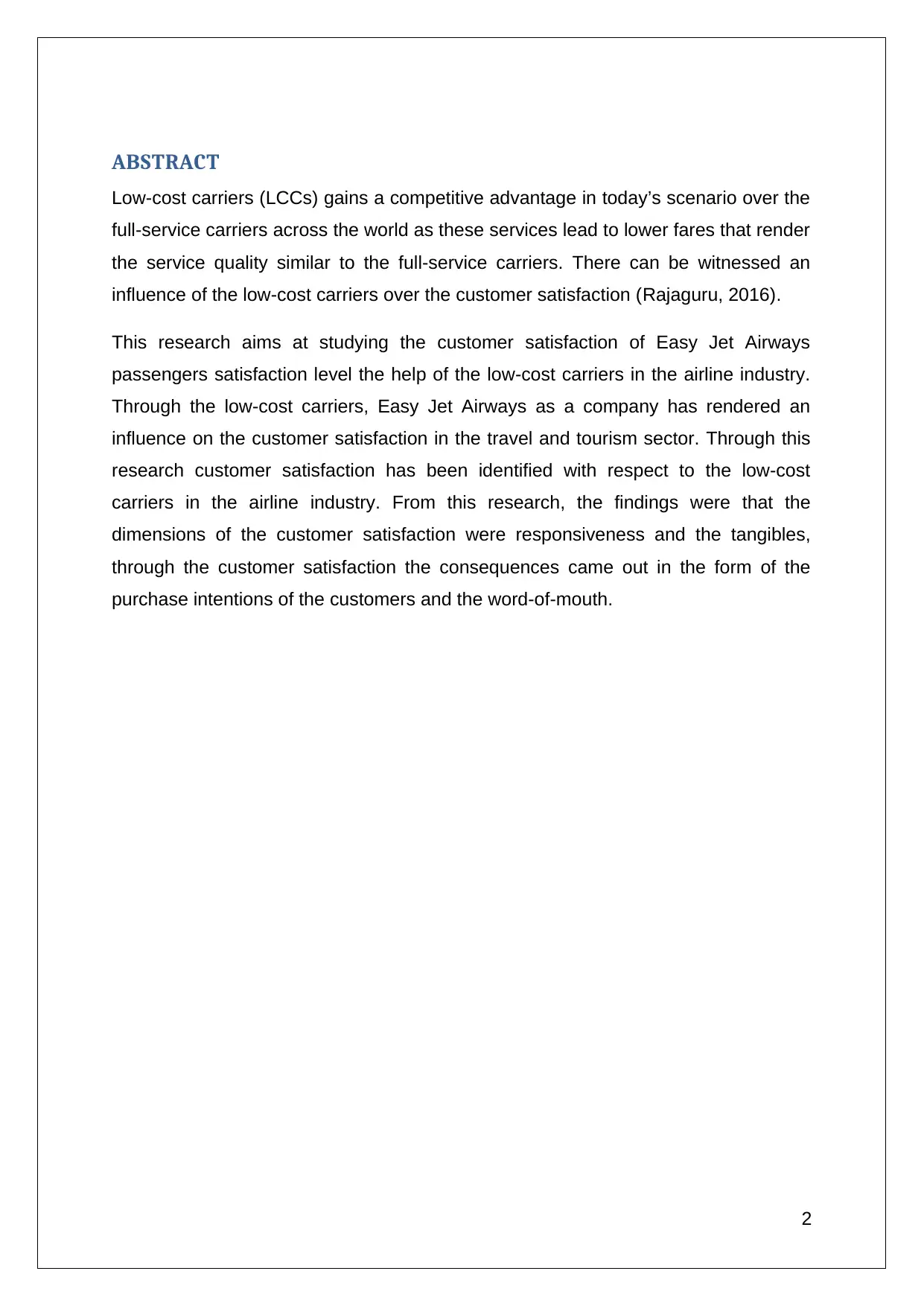
ABSTRACT
Low-cost carriers (LCCs) gains a competitive advantage in today’s scenario over the
full-service carriers across the world as these services lead to lower fares that render
the service quality similar to the full-service carriers. There can be witnessed an
influence of the low-cost carriers over the customer satisfaction (Rajaguru, 2016).
This research aims at studying the customer satisfaction of Easy Jet Airways
passengers satisfaction level the help of the low-cost carriers in the airline industry.
Through the low-cost carriers, Easy Jet Airways as a company has rendered an
influence on the customer satisfaction in the travel and tourism sector. Through this
research customer satisfaction has been identified with respect to the low-cost
carriers in the airline industry. From this research, the findings were that the
dimensions of the customer satisfaction were responsiveness and the tangibles,
through the customer satisfaction the consequences came out in the form of the
purchase intentions of the customers and the word-of-mouth.
2
Low-cost carriers (LCCs) gains a competitive advantage in today’s scenario over the
full-service carriers across the world as these services lead to lower fares that render
the service quality similar to the full-service carriers. There can be witnessed an
influence of the low-cost carriers over the customer satisfaction (Rajaguru, 2016).
This research aims at studying the customer satisfaction of Easy Jet Airways
passengers satisfaction level the help of the low-cost carriers in the airline industry.
Through the low-cost carriers, Easy Jet Airways as a company has rendered an
influence on the customer satisfaction in the travel and tourism sector. Through this
research customer satisfaction has been identified with respect to the low-cost
carriers in the airline industry. From this research, the findings were that the
dimensions of the customer satisfaction were responsiveness and the tangibles,
through the customer satisfaction the consequences came out in the form of the
purchase intentions of the customers and the word-of-mouth.
2
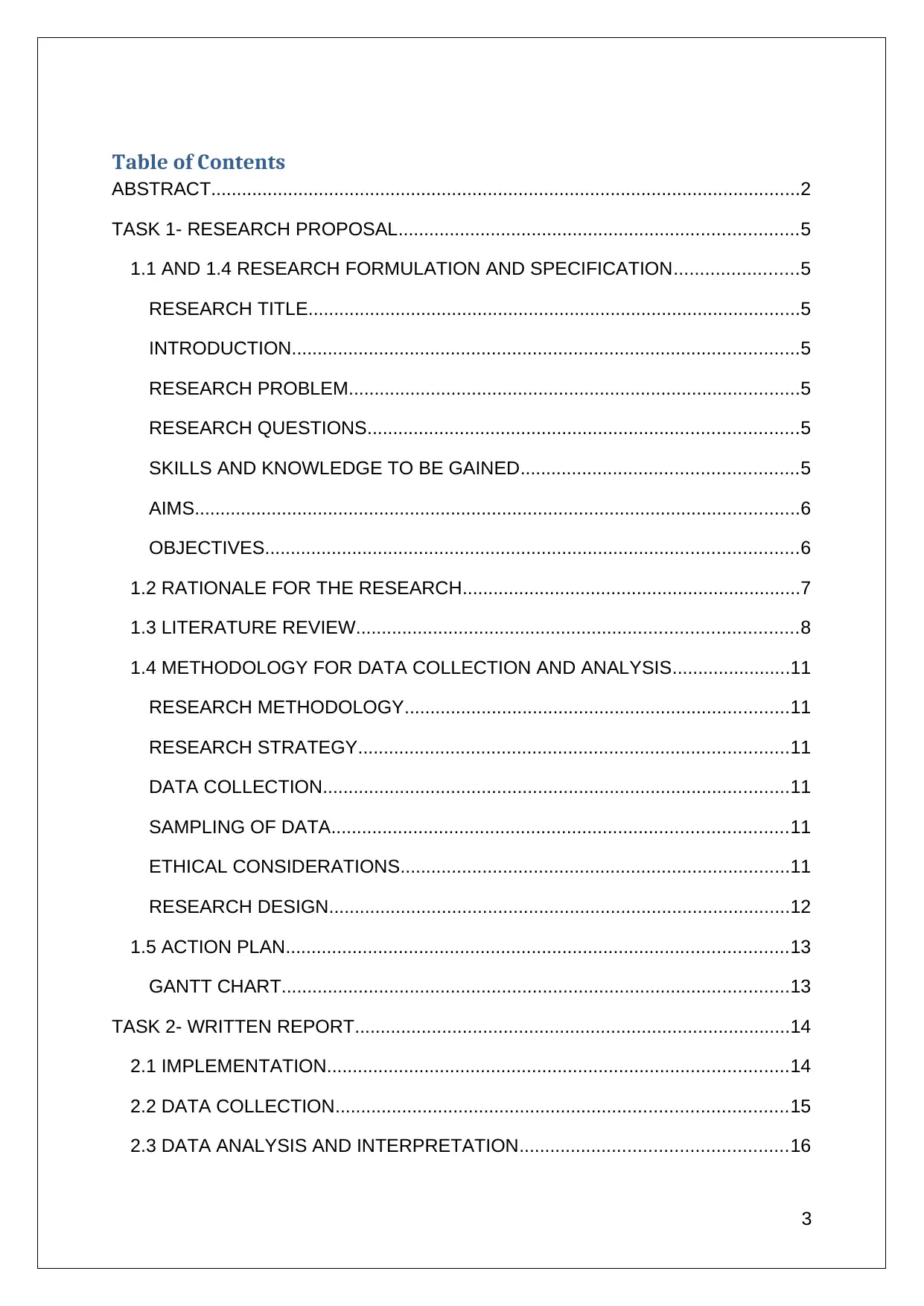
Table of Contents
ABSTRACT...................................................................................................................2
TASK 1- RESEARCH PROPOSAL..............................................................................5
1.1 AND 1.4 RESEARCH FORMULATION AND SPECIFICATION........................5
RESEARCH TITLE................................................................................................5
INTRODUCTION...................................................................................................5
RESEARCH PROBLEM........................................................................................5
RESEARCH QUESTIONS....................................................................................5
SKILLS AND KNOWLEDGE TO BE GAINED......................................................5
AIMS......................................................................................................................6
OBJECTIVES........................................................................................................6
1.2 RATIONALE FOR THE RESEARCH..................................................................7
1.3 LITERATURE REVIEW......................................................................................8
1.4 METHODOLOGY FOR DATA COLLECTION AND ANALYSIS.......................11
RESEARCH METHODOLOGY...........................................................................11
RESEARCH STRATEGY....................................................................................11
DATA COLLECTION...........................................................................................11
SAMPLING OF DATA.........................................................................................11
ETHICAL CONSIDERATIONS............................................................................11
RESEARCH DESIGN..........................................................................................12
1.5 ACTION PLAN..................................................................................................13
GANTT CHART...................................................................................................13
TASK 2- WRITTEN REPORT.....................................................................................14
2.1 IMPLEMENTATION..........................................................................................14
2.2 DATA COLLECTION........................................................................................15
2.3 DATA ANALYSIS AND INTERPRETATION....................................................16
3
ABSTRACT...................................................................................................................2
TASK 1- RESEARCH PROPOSAL..............................................................................5
1.1 AND 1.4 RESEARCH FORMULATION AND SPECIFICATION........................5
RESEARCH TITLE................................................................................................5
INTRODUCTION...................................................................................................5
RESEARCH PROBLEM........................................................................................5
RESEARCH QUESTIONS....................................................................................5
SKILLS AND KNOWLEDGE TO BE GAINED......................................................5
AIMS......................................................................................................................6
OBJECTIVES........................................................................................................6
1.2 RATIONALE FOR THE RESEARCH..................................................................7
1.3 LITERATURE REVIEW......................................................................................8
1.4 METHODOLOGY FOR DATA COLLECTION AND ANALYSIS.......................11
RESEARCH METHODOLOGY...........................................................................11
RESEARCH STRATEGY....................................................................................11
DATA COLLECTION...........................................................................................11
SAMPLING OF DATA.........................................................................................11
ETHICAL CONSIDERATIONS............................................................................11
RESEARCH DESIGN..........................................................................................12
1.5 ACTION PLAN..................................................................................................13
GANTT CHART...................................................................................................13
TASK 2- WRITTEN REPORT.....................................................................................14
2.1 IMPLEMENTATION..........................................................................................14
2.2 DATA COLLECTION........................................................................................15
2.3 DATA ANALYSIS AND INTERPRETATION....................................................16
3
⊘ This is a preview!⊘
Do you want full access?
Subscribe today to unlock all pages.

Trusted by 1+ million students worldwide
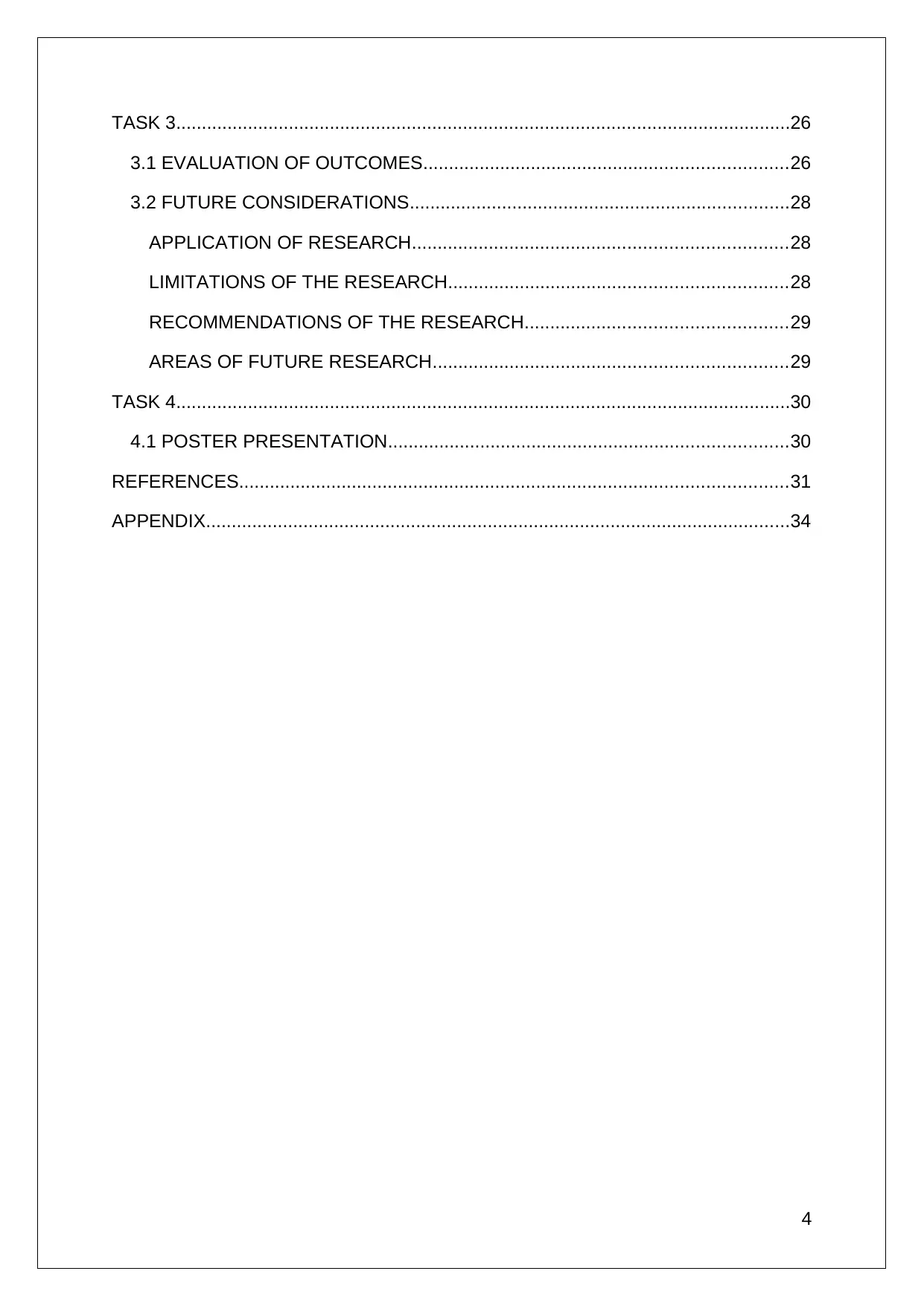
TASK 3........................................................................................................................26
3.1 EVALUATION OF OUTCOMES.......................................................................26
3.2 FUTURE CONSIDERATIONS..........................................................................28
APPLICATION OF RESEARCH.........................................................................28
LIMITATIONS OF THE RESEARCH..................................................................28
RECOMMENDATIONS OF THE RESEARCH...................................................29
AREAS OF FUTURE RESEARCH.....................................................................29
TASK 4........................................................................................................................30
4.1 POSTER PRESENTATION..............................................................................30
REFERENCES...........................................................................................................31
APPENDIX..................................................................................................................34
4
3.1 EVALUATION OF OUTCOMES.......................................................................26
3.2 FUTURE CONSIDERATIONS..........................................................................28
APPLICATION OF RESEARCH.........................................................................28
LIMITATIONS OF THE RESEARCH..................................................................28
RECOMMENDATIONS OF THE RESEARCH...................................................29
AREAS OF FUTURE RESEARCH.....................................................................29
TASK 4........................................................................................................................30
4.1 POSTER PRESENTATION..............................................................................30
REFERENCES...........................................................................................................31
APPENDIX..................................................................................................................34
4
Paraphrase This Document
Need a fresh take? Get an instant paraphrase of this document with our AI Paraphraser
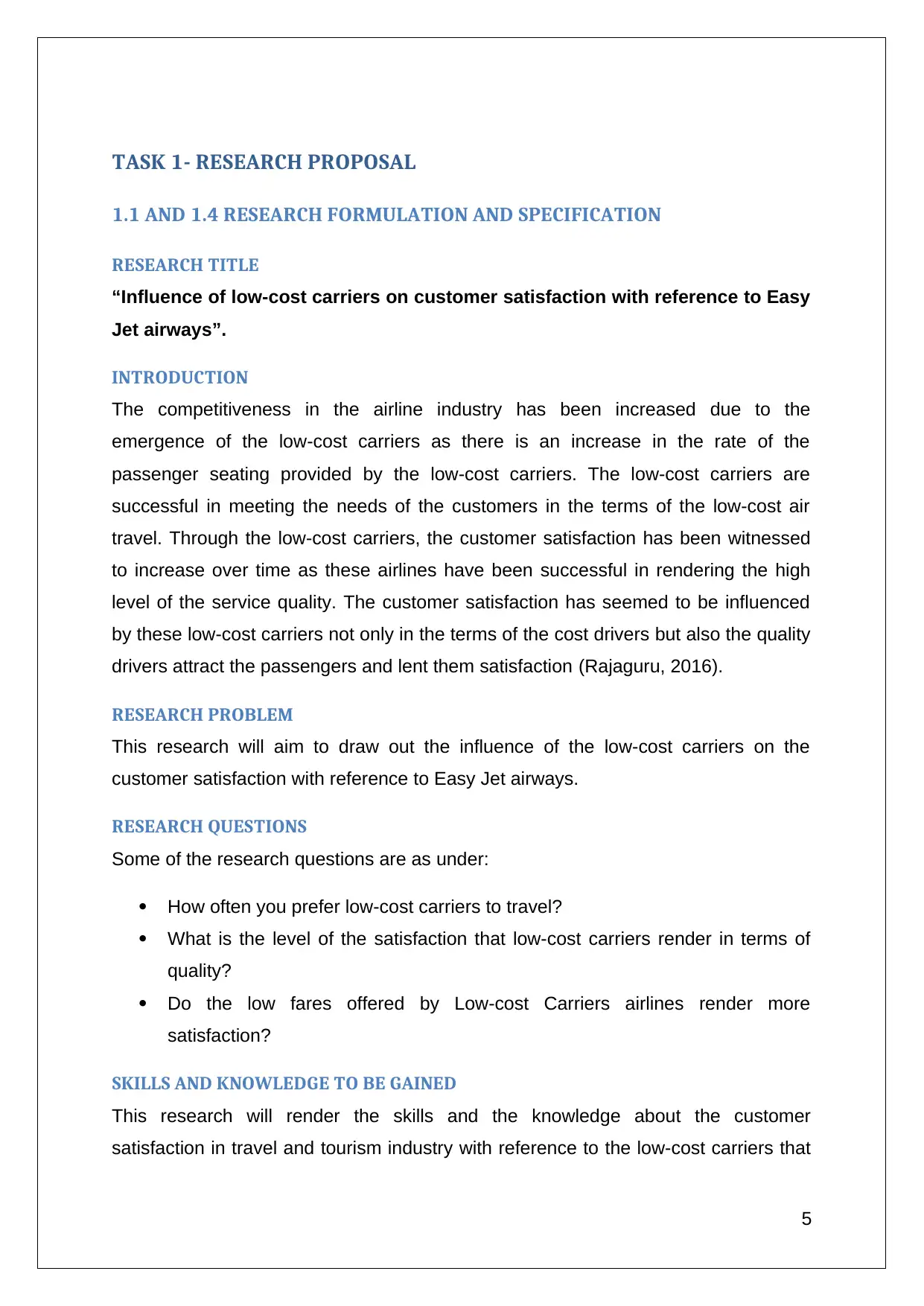
TASK 1- RESEARCH PROPOSAL
1.1 AND 1.4 RESEARCH FORMULATION AND SPECIFICATION
RESEARCH TITLE
“Influence of low-cost carriers on customer satisfaction with reference to Easy
Jet airways”.
INTRODUCTION
The competitiveness in the airline industry has been increased due to the
emergence of the low-cost carriers as there is an increase in the rate of the
passenger seating provided by the low-cost carriers. The low-cost carriers are
successful in meeting the needs of the customers in the terms of the low-cost air
travel. Through the low-cost carriers, the customer satisfaction has been witnessed
to increase over time as these airlines have been successful in rendering the high
level of the service quality. The customer satisfaction has seemed to be influenced
by these low-cost carriers not only in the terms of the cost drivers but also the quality
drivers attract the passengers and lent them satisfaction (Rajaguru, 2016).
RESEARCH PROBLEM
This research will aim to draw out the influence of the low-cost carriers on the
customer satisfaction with reference to Easy Jet airways.
RESEARCH QUESTIONS
Some of the research questions are as under:
How often you prefer low-cost carriers to travel?
What is the level of the satisfaction that low-cost carriers render in terms of
quality?
Do the low fares offered by Low-cost Carriers airlines render more
satisfaction?
SKILLS AND KNOWLEDGE TO BE GAINED
This research will render the skills and the knowledge about the customer
satisfaction in travel and tourism industry with reference to the low-cost carriers that
5
1.1 AND 1.4 RESEARCH FORMULATION AND SPECIFICATION
RESEARCH TITLE
“Influence of low-cost carriers on customer satisfaction with reference to Easy
Jet airways”.
INTRODUCTION
The competitiveness in the airline industry has been increased due to the
emergence of the low-cost carriers as there is an increase in the rate of the
passenger seating provided by the low-cost carriers. The low-cost carriers are
successful in meeting the needs of the customers in the terms of the low-cost air
travel. Through the low-cost carriers, the customer satisfaction has been witnessed
to increase over time as these airlines have been successful in rendering the high
level of the service quality. The customer satisfaction has seemed to be influenced
by these low-cost carriers not only in the terms of the cost drivers but also the quality
drivers attract the passengers and lent them satisfaction (Rajaguru, 2016).
RESEARCH PROBLEM
This research will aim to draw out the influence of the low-cost carriers on the
customer satisfaction with reference to Easy Jet airways.
RESEARCH QUESTIONS
Some of the research questions are as under:
How often you prefer low-cost carriers to travel?
What is the level of the satisfaction that low-cost carriers render in terms of
quality?
Do the low fares offered by Low-cost Carriers airlines render more
satisfaction?
SKILLS AND KNOWLEDGE TO BE GAINED
This research will render the skills and the knowledge about the customer
satisfaction in travel and tourism industry with reference to the low-cost carriers that
5
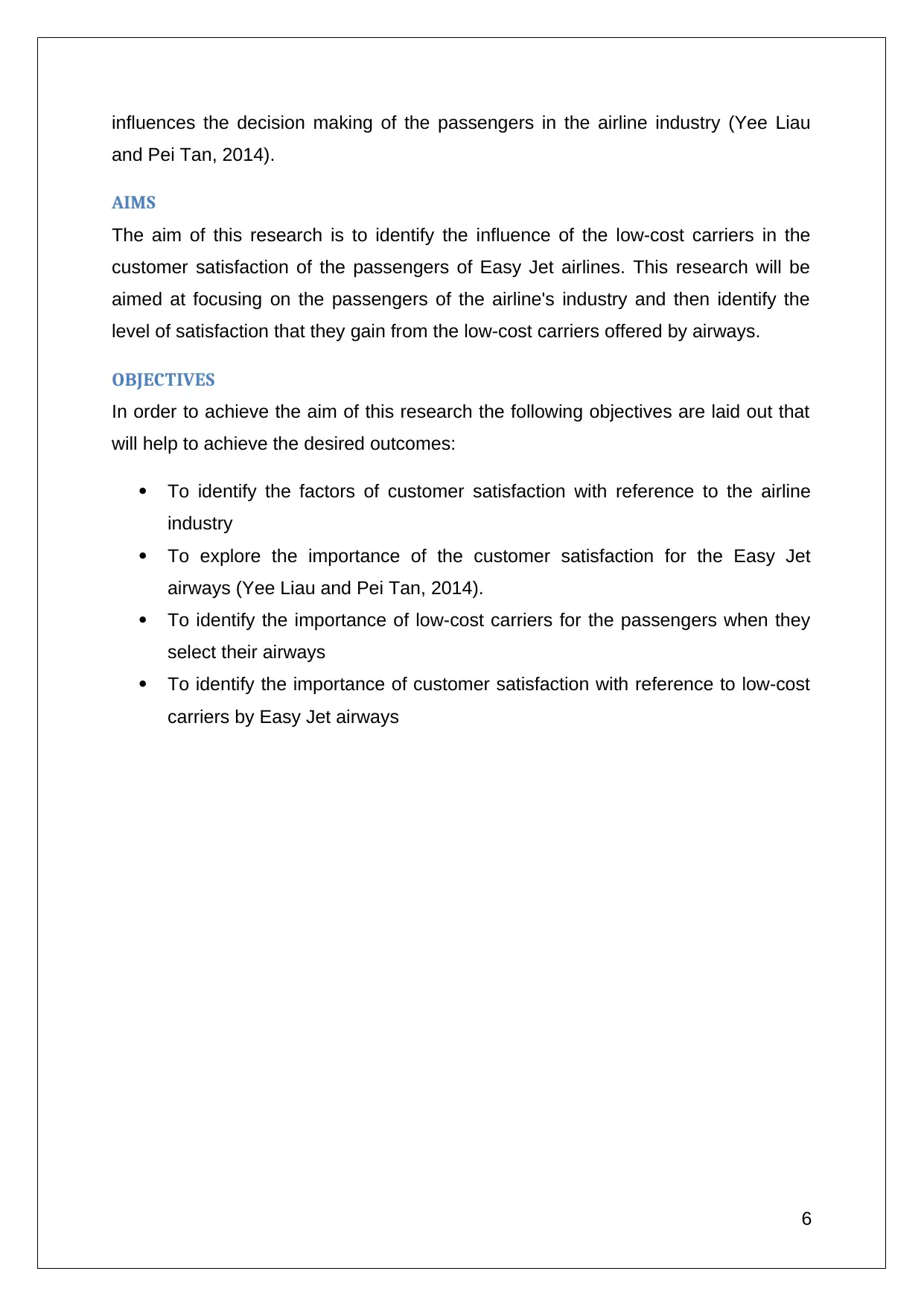
influences the decision making of the passengers in the airline industry (Yee Liau
and Pei Tan, 2014).
AIMS
The aim of this research is to identify the influence of the low-cost carriers in the
customer satisfaction of the passengers of Easy Jet airlines. This research will be
aimed at focusing on the passengers of the airline's industry and then identify the
level of satisfaction that they gain from the low-cost carriers offered by airways.
OBJECTIVES
In order to achieve the aim of this research the following objectives are laid out that
will help to achieve the desired outcomes:
To identify the factors of customer satisfaction with reference to the airline
industry
To explore the importance of the customer satisfaction for the Easy Jet
airways (Yee Liau and Pei Tan, 2014).
To identify the importance of low-cost carriers for the passengers when they
select their airways
To identify the importance of customer satisfaction with reference to low-cost
carriers by Easy Jet airways
6
and Pei Tan, 2014).
AIMS
The aim of this research is to identify the influence of the low-cost carriers in the
customer satisfaction of the passengers of Easy Jet airlines. This research will be
aimed at focusing on the passengers of the airline's industry and then identify the
level of satisfaction that they gain from the low-cost carriers offered by airways.
OBJECTIVES
In order to achieve the aim of this research the following objectives are laid out that
will help to achieve the desired outcomes:
To identify the factors of customer satisfaction with reference to the airline
industry
To explore the importance of the customer satisfaction for the Easy Jet
airways (Yee Liau and Pei Tan, 2014).
To identify the importance of low-cost carriers for the passengers when they
select their airways
To identify the importance of customer satisfaction with reference to low-cost
carriers by Easy Jet airways
6
⊘ This is a preview!⊘
Do you want full access?
Subscribe today to unlock all pages.

Trusted by 1+ million students worldwide
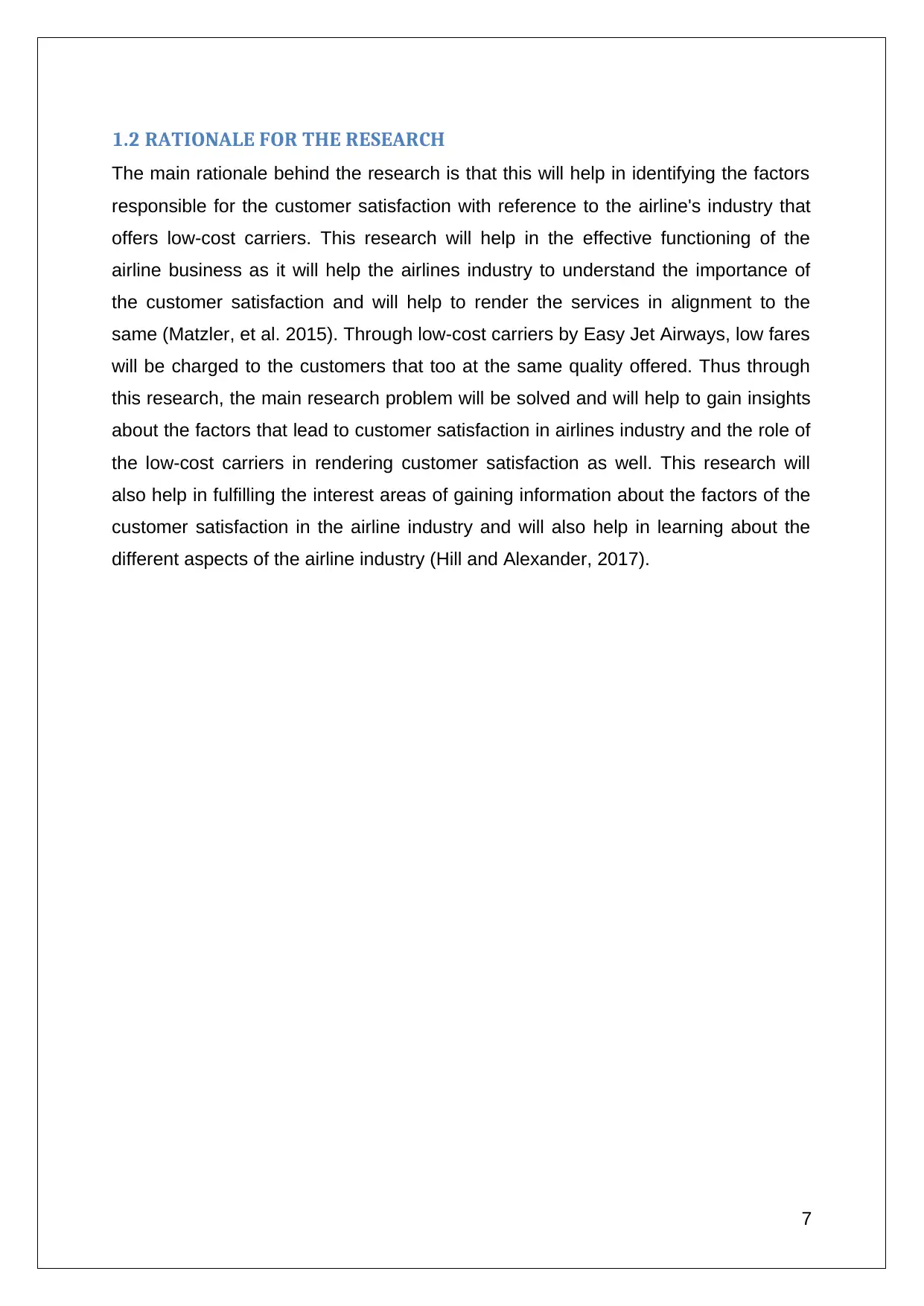
1.2 RATIONALE FOR THE RESEARCH
The main rationale behind the research is that this will help in identifying the factors
responsible for the customer satisfaction with reference to the airline's industry that
offers low-cost carriers. This research will help in the effective functioning of the
airline business as it will help the airlines industry to understand the importance of
the customer satisfaction and will help to render the services in alignment to the
same (Matzler, et al. 2015). Through low-cost carriers by Easy Jet Airways, low fares
will be charged to the customers that too at the same quality offered. Thus through
this research, the main research problem will be solved and will help to gain insights
about the factors that lead to customer satisfaction in airlines industry and the role of
the low-cost carriers in rendering customer satisfaction as well. This research will
also help in fulfilling the interest areas of gaining information about the factors of the
customer satisfaction in the airline industry and will also help in learning about the
different aspects of the airline industry (Hill and Alexander, 2017).
7
The main rationale behind the research is that this will help in identifying the factors
responsible for the customer satisfaction with reference to the airline's industry that
offers low-cost carriers. This research will help in the effective functioning of the
airline business as it will help the airlines industry to understand the importance of
the customer satisfaction and will help to render the services in alignment to the
same (Matzler, et al. 2015). Through low-cost carriers by Easy Jet Airways, low fares
will be charged to the customers that too at the same quality offered. Thus through
this research, the main research problem will be solved and will help to gain insights
about the factors that lead to customer satisfaction in airlines industry and the role of
the low-cost carriers in rendering customer satisfaction as well. This research will
also help in fulfilling the interest areas of gaining information about the factors of the
customer satisfaction in the airline industry and will also help in learning about the
different aspects of the airline industry (Hill and Alexander, 2017).
7
Paraphrase This Document
Need a fresh take? Get an instant paraphrase of this document with our AI Paraphraser
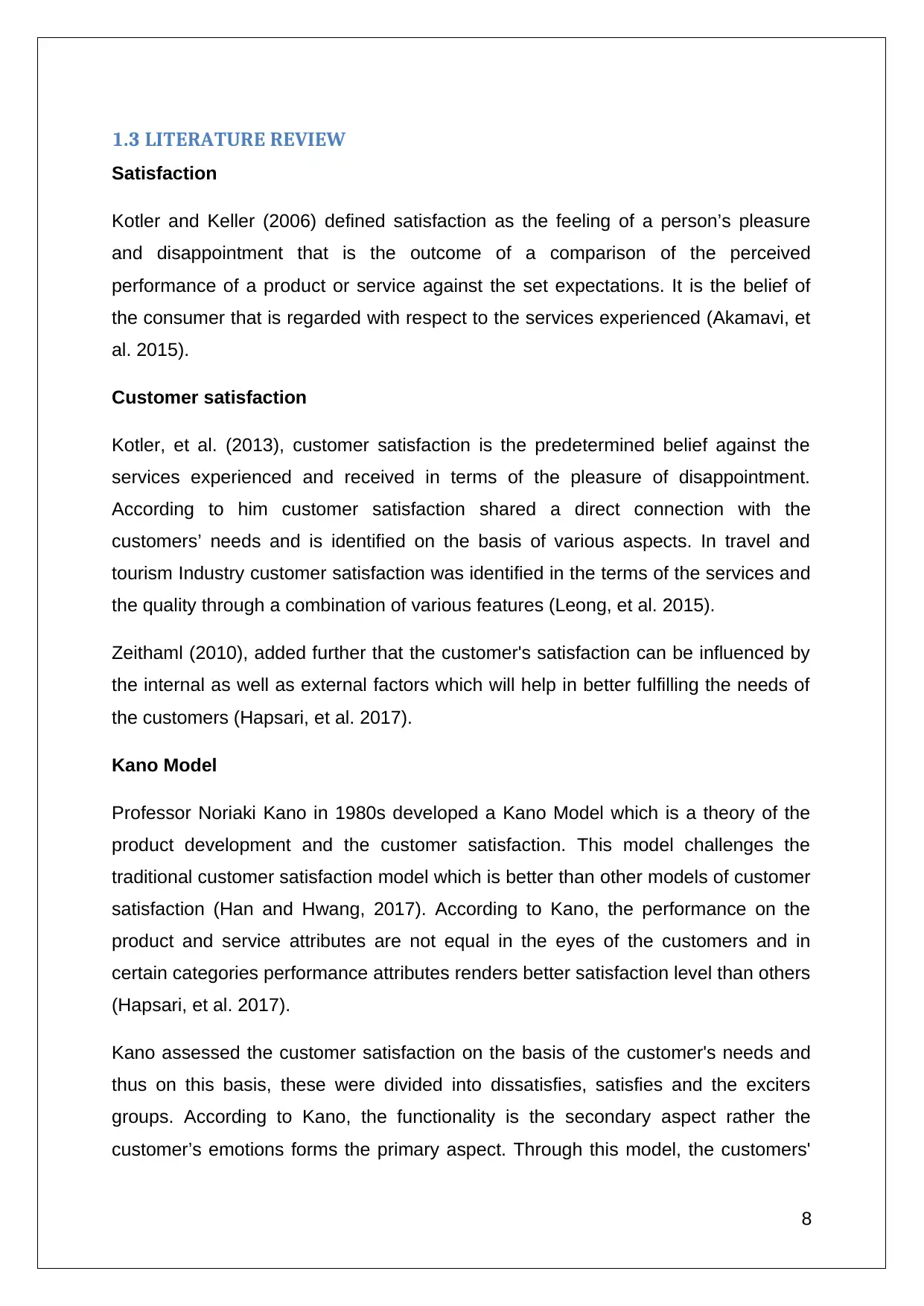
1.3 LITERATURE REVIEW
Satisfaction
Kotler and Keller (2006) defined satisfaction as the feeling of a person’s pleasure
and disappointment that is the outcome of a comparison of the perceived
performance of a product or service against the set expectations. It is the belief of
the consumer that is regarded with respect to the services experienced (Akamavi, et
al. 2015).
Customer satisfaction
Kotler, et al. (2013), customer satisfaction is the predetermined belief against the
services experienced and received in terms of the pleasure of disappointment.
According to him customer satisfaction shared a direct connection with the
customers’ needs and is identified on the basis of various aspects. In travel and
tourism Industry customer satisfaction was identified in the terms of the services and
the quality through a combination of various features (Leong, et al. 2015).
Zeithaml (2010), added further that the customer's satisfaction can be influenced by
the internal as well as external factors which will help in better fulfilling the needs of
the customers (Hapsari, et al. 2017).
Kano Model
Professor Noriaki Kano in 1980s developed a Kano Model which is a theory of the
product development and the customer satisfaction. This model challenges the
traditional customer satisfaction model which is better than other models of customer
satisfaction (Han and Hwang, 2017). According to Kano, the performance on the
product and service attributes are not equal in the eyes of the customers and in
certain categories performance attributes renders better satisfaction level than others
(Hapsari, et al. 2017).
Kano assessed the customer satisfaction on the basis of the customer's needs and
thus on this basis, these were divided into dissatisfies, satisfies and the exciters
groups. According to Kano, the functionality is the secondary aspect rather the
customer’s emotions forms the primary aspect. Through this model, the customers'
8
Satisfaction
Kotler and Keller (2006) defined satisfaction as the feeling of a person’s pleasure
and disappointment that is the outcome of a comparison of the perceived
performance of a product or service against the set expectations. It is the belief of
the consumer that is regarded with respect to the services experienced (Akamavi, et
al. 2015).
Customer satisfaction
Kotler, et al. (2013), customer satisfaction is the predetermined belief against the
services experienced and received in terms of the pleasure of disappointment.
According to him customer satisfaction shared a direct connection with the
customers’ needs and is identified on the basis of various aspects. In travel and
tourism Industry customer satisfaction was identified in the terms of the services and
the quality through a combination of various features (Leong, et al. 2015).
Zeithaml (2010), added further that the customer's satisfaction can be influenced by
the internal as well as external factors which will help in better fulfilling the needs of
the customers (Hapsari, et al. 2017).
Kano Model
Professor Noriaki Kano in 1980s developed a Kano Model which is a theory of the
product development and the customer satisfaction. This model challenges the
traditional customer satisfaction model which is better than other models of customer
satisfaction (Han and Hwang, 2017). According to Kano, the performance on the
product and service attributes are not equal in the eyes of the customers and in
certain categories performance attributes renders better satisfaction level than others
(Hapsari, et al. 2017).
Kano assessed the customer satisfaction on the basis of the customer's needs and
thus on this basis, these were divided into dissatisfies, satisfies and the exciters
groups. According to Kano, the functionality is the secondary aspect rather the
customer’s emotions forms the primary aspect. Through this model, the customers'
8
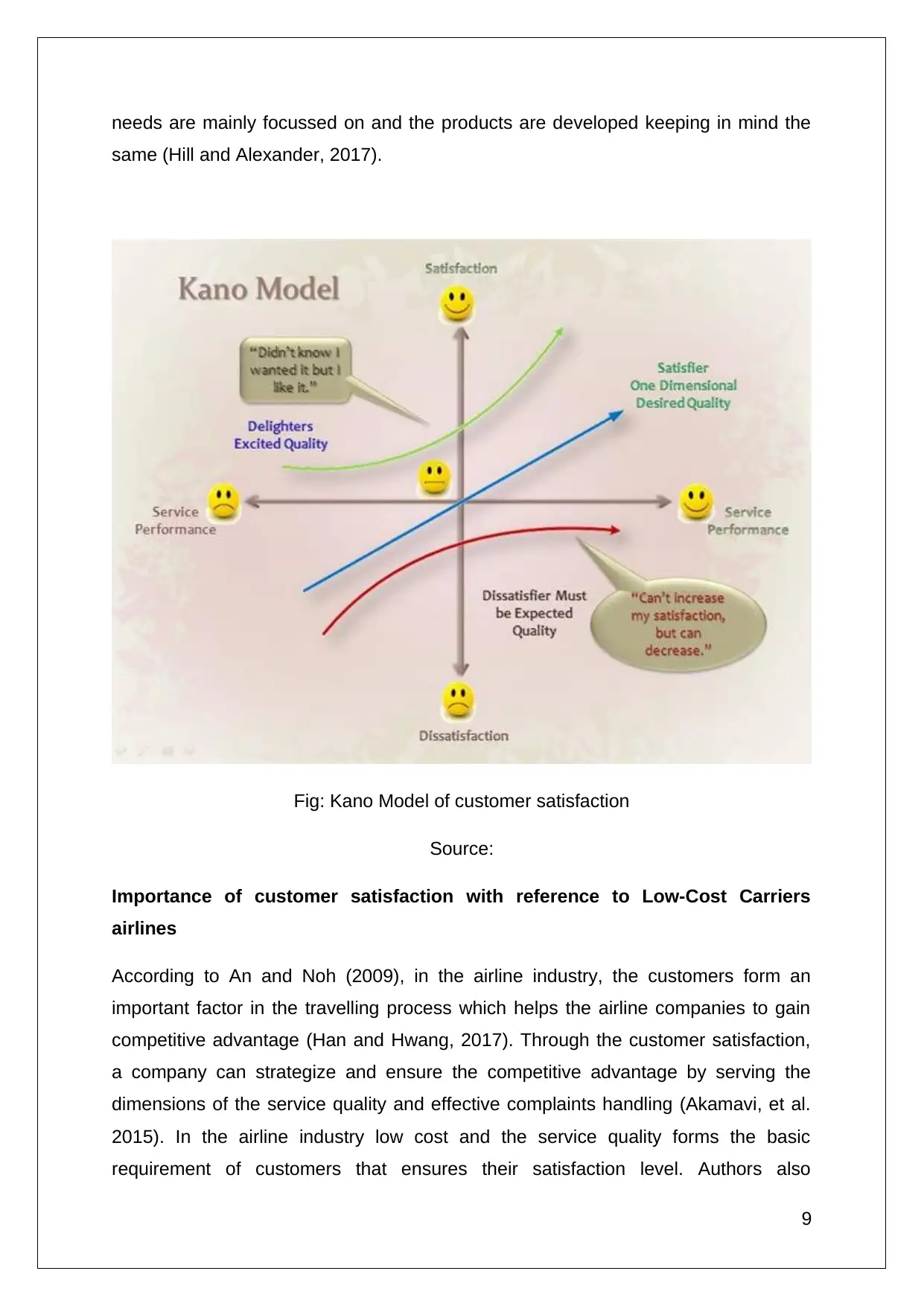
needs are mainly focussed on and the products are developed keeping in mind the
same (Hill and Alexander, 2017).
Fig: Kano Model of customer satisfaction
Source:
Importance of customer satisfaction with reference to Low-Cost Carriers
airlines
According to An and Noh (2009), in the airline industry, the customers form an
important factor in the travelling process which helps the airline companies to gain
competitive advantage (Han and Hwang, 2017). Through the customer satisfaction,
a company can strategize and ensure the competitive advantage by serving the
dimensions of the service quality and effective complaints handling (Akamavi, et al.
2015). In the airline industry low cost and the service quality forms the basic
requirement of customers that ensures their satisfaction level. Authors also
9
same (Hill and Alexander, 2017).
Fig: Kano Model of customer satisfaction
Source:
Importance of customer satisfaction with reference to Low-Cost Carriers
airlines
According to An and Noh (2009), in the airline industry, the customers form an
important factor in the travelling process which helps the airline companies to gain
competitive advantage (Han and Hwang, 2017). Through the customer satisfaction,
a company can strategize and ensure the competitive advantage by serving the
dimensions of the service quality and effective complaints handling (Akamavi, et al.
2015). In the airline industry low cost and the service quality forms the basic
requirement of customers that ensures their satisfaction level. Authors also
9
⊘ This is a preview!⊘
Do you want full access?
Subscribe today to unlock all pages.

Trusted by 1+ million students worldwide
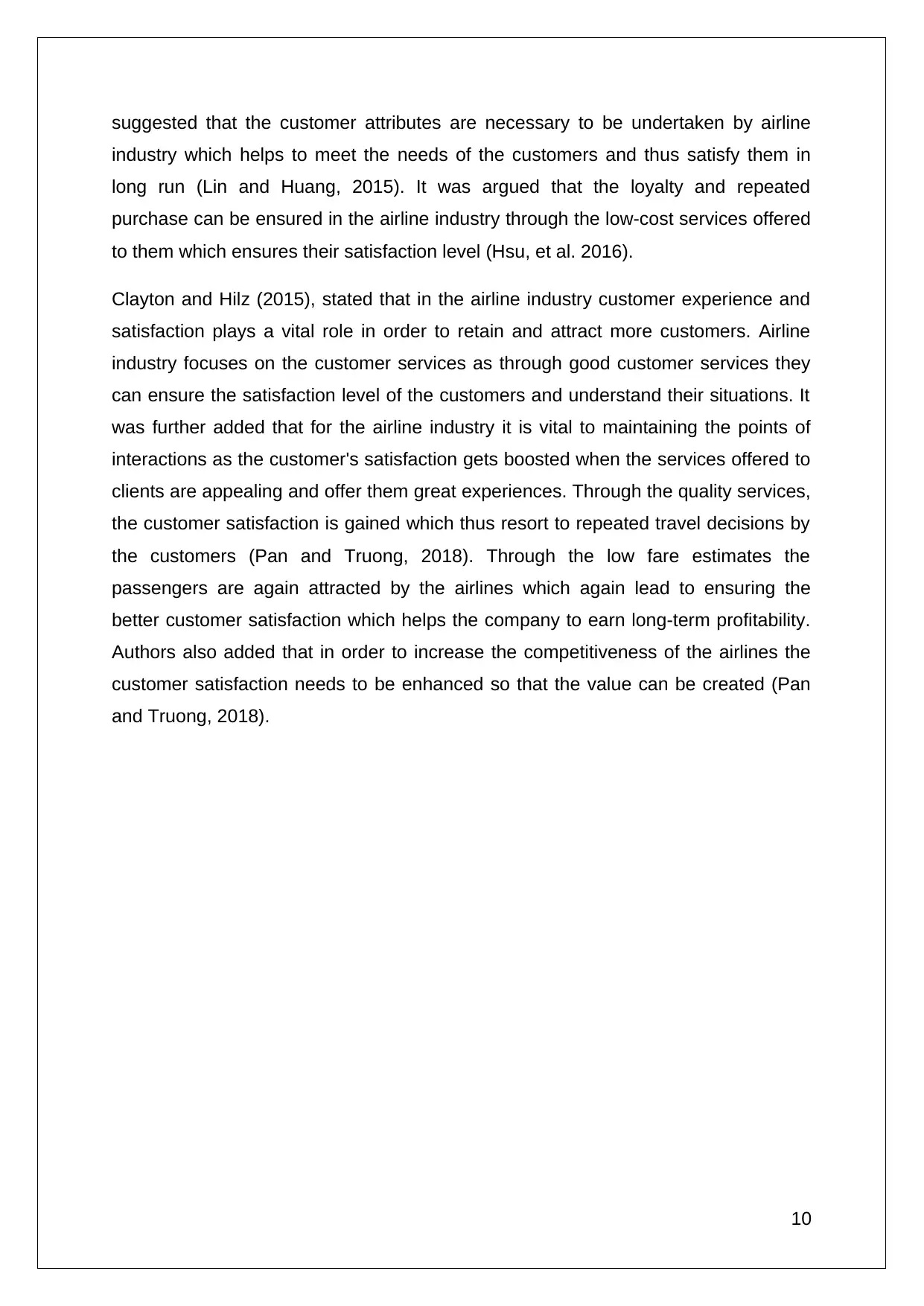
suggested that the customer attributes are necessary to be undertaken by airline
industry which helps to meet the needs of the customers and thus satisfy them in
long run (Lin and Huang, 2015). It was argued that the loyalty and repeated
purchase can be ensured in the airline industry through the low-cost services offered
to them which ensures their satisfaction level (Hsu, et al. 2016).
Clayton and Hilz (2015), stated that in the airline industry customer experience and
satisfaction plays a vital role in order to retain and attract more customers. Airline
industry focuses on the customer services as through good customer services they
can ensure the satisfaction level of the customers and understand their situations. It
was further added that for the airline industry it is vital to maintaining the points of
interactions as the customer's satisfaction gets boosted when the services offered to
clients are appealing and offer them great experiences. Through the quality services,
the customer satisfaction is gained which thus resort to repeated travel decisions by
the customers (Pan and Truong, 2018). Through the low fare estimates the
passengers are again attracted by the airlines which again lead to ensuring the
better customer satisfaction which helps the company to earn long-term profitability.
Authors also added that in order to increase the competitiveness of the airlines the
customer satisfaction needs to be enhanced so that the value can be created (Pan
and Truong, 2018).
10
industry which helps to meet the needs of the customers and thus satisfy them in
long run (Lin and Huang, 2015). It was argued that the loyalty and repeated
purchase can be ensured in the airline industry through the low-cost services offered
to them which ensures their satisfaction level (Hsu, et al. 2016).
Clayton and Hilz (2015), stated that in the airline industry customer experience and
satisfaction plays a vital role in order to retain and attract more customers. Airline
industry focuses on the customer services as through good customer services they
can ensure the satisfaction level of the customers and understand their situations. It
was further added that for the airline industry it is vital to maintaining the points of
interactions as the customer's satisfaction gets boosted when the services offered to
clients are appealing and offer them great experiences. Through the quality services,
the customer satisfaction is gained which thus resort to repeated travel decisions by
the customers (Pan and Truong, 2018). Through the low fare estimates the
passengers are again attracted by the airlines which again lead to ensuring the
better customer satisfaction which helps the company to earn long-term profitability.
Authors also added that in order to increase the competitiveness of the airlines the
customer satisfaction needs to be enhanced so that the value can be created (Pan
and Truong, 2018).
10
Paraphrase This Document
Need a fresh take? Get an instant paraphrase of this document with our AI Paraphraser
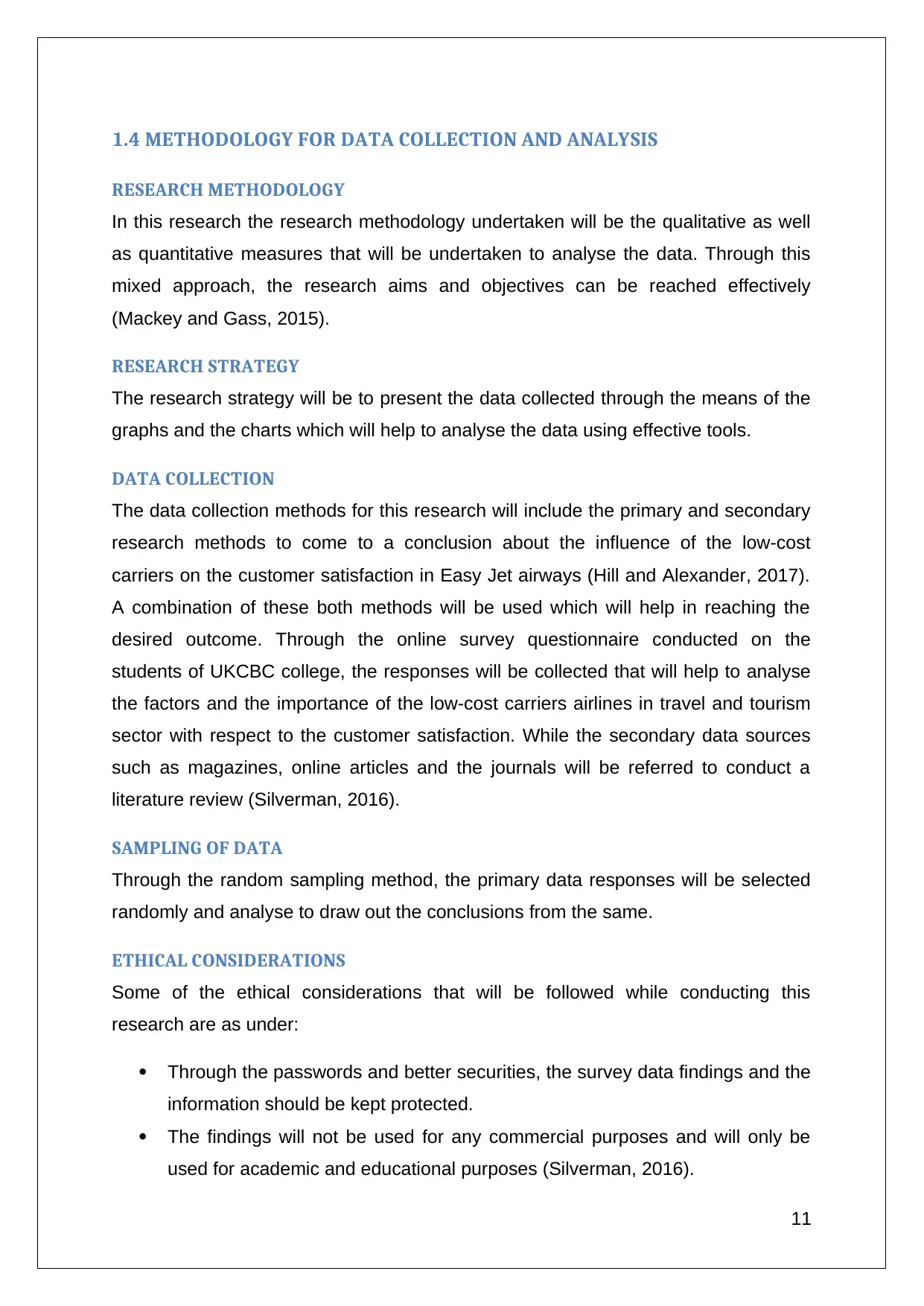
1.4 METHODOLOGY FOR DATA COLLECTION AND ANALYSIS
RESEARCH METHODOLOGY
In this research the research methodology undertaken will be the qualitative as well
as quantitative measures that will be undertaken to analyse the data. Through this
mixed approach, the research aims and objectives can be reached effectively
(Mackey and Gass, 2015).
RESEARCH STRATEGY
The research strategy will be to present the data collected through the means of the
graphs and the charts which will help to analyse the data using effective tools.
DATA COLLECTION
The data collection methods for this research will include the primary and secondary
research methods to come to a conclusion about the influence of the low-cost
carriers on the customer satisfaction in Easy Jet airways (Hill and Alexander, 2017).
A combination of these both methods will be used which will help in reaching the
desired outcome. Through the online survey questionnaire conducted on the
students of UKCBC college, the responses will be collected that will help to analyse
the factors and the importance of the low-cost carriers airlines in travel and tourism
sector with respect to the customer satisfaction. While the secondary data sources
such as magazines, online articles and the journals will be referred to conduct a
literature review (Silverman, 2016).
SAMPLING OF DATA
Through the random sampling method, the primary data responses will be selected
randomly and analyse to draw out the conclusions from the same.
ETHICAL CONSIDERATIONS
Some of the ethical considerations that will be followed while conducting this
research are as under:
Through the passwords and better securities, the survey data findings and the
information should be kept protected.
The findings will not be used for any commercial purposes and will only be
used for academic and educational purposes (Silverman, 2016).
11
RESEARCH METHODOLOGY
In this research the research methodology undertaken will be the qualitative as well
as quantitative measures that will be undertaken to analyse the data. Through this
mixed approach, the research aims and objectives can be reached effectively
(Mackey and Gass, 2015).
RESEARCH STRATEGY
The research strategy will be to present the data collected through the means of the
graphs and the charts which will help to analyse the data using effective tools.
DATA COLLECTION
The data collection methods for this research will include the primary and secondary
research methods to come to a conclusion about the influence of the low-cost
carriers on the customer satisfaction in Easy Jet airways (Hill and Alexander, 2017).
A combination of these both methods will be used which will help in reaching the
desired outcome. Through the online survey questionnaire conducted on the
students of UKCBC college, the responses will be collected that will help to analyse
the factors and the importance of the low-cost carriers airlines in travel and tourism
sector with respect to the customer satisfaction. While the secondary data sources
such as magazines, online articles and the journals will be referred to conduct a
literature review (Silverman, 2016).
SAMPLING OF DATA
Through the random sampling method, the primary data responses will be selected
randomly and analyse to draw out the conclusions from the same.
ETHICAL CONSIDERATIONS
Some of the ethical considerations that will be followed while conducting this
research are as under:
Through the passwords and better securities, the survey data findings and the
information should be kept protected.
The findings will not be used for any commercial purposes and will only be
used for academic and educational purposes (Silverman, 2016).
11
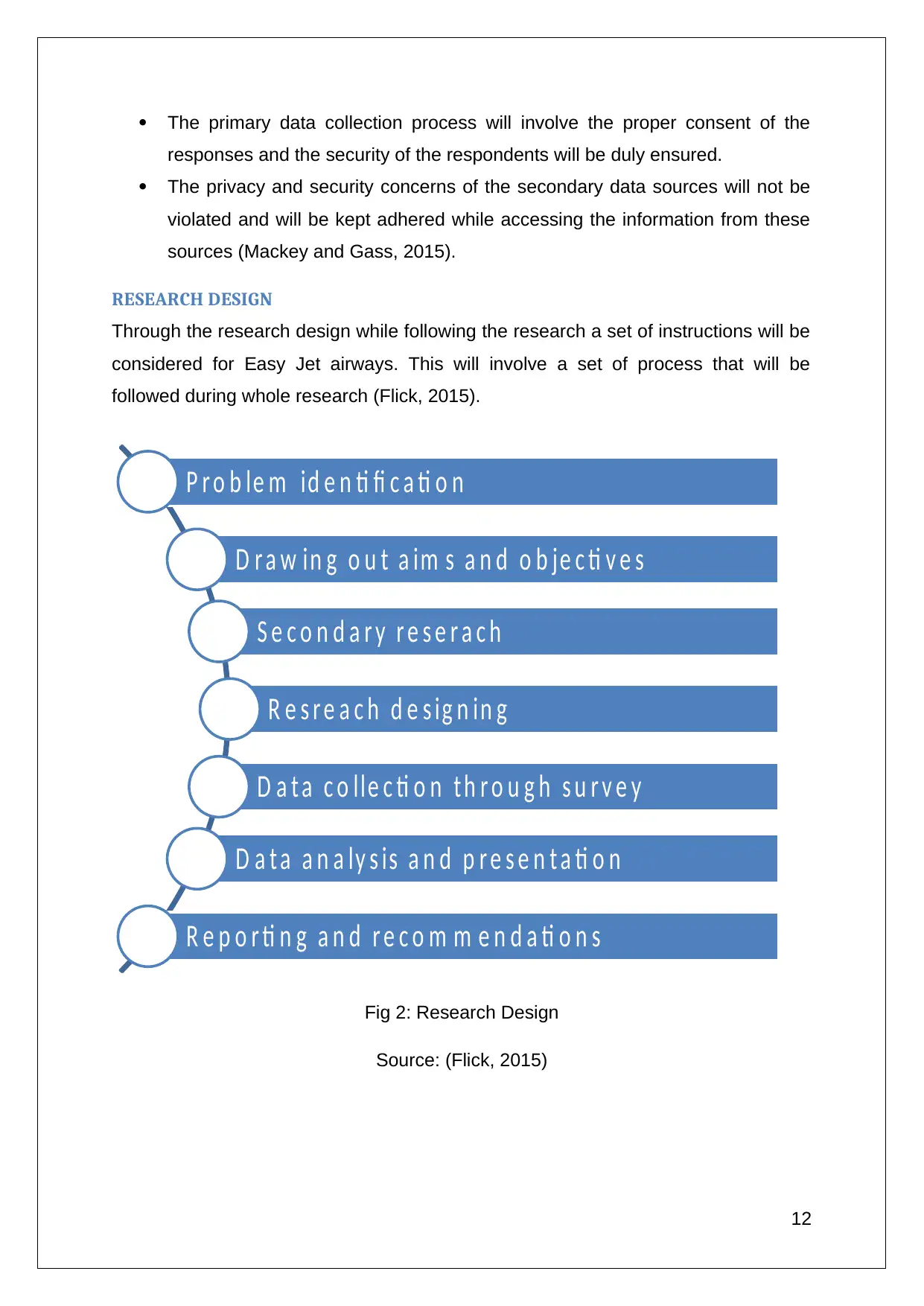
The primary data collection process will involve the proper consent of the
responses and the security of the respondents will be duly ensured.
The privacy and security concerns of the secondary data sources will not be
violated and will be kept adhered while accessing the information from these
sources (Mackey and Gass, 2015).
RESEARCH DESIGN
Through the research design while following the research a set of instructions will be
considered for Easy Jet airways. This will involve a set of process that will be
followed during whole research (Flick, 2015).
Fig 2: Research Design
Source: (Flick, 2015)
12
P r o b le m id e n ti fi c a ti o n
D r a w in g o u t a im s a n d o b je c ti v e s
S e c o n d a r y r e s e r a c h
R e s r e a c h d e s ig n in g
D a t a c o lle c ti o n t h r o u g h s u r v e y
D a t a a n a ly s is a n d p r e s e n t a ti o n
R e p o r ti n g a n d r e c o m m e n d a ti o n s
responses and the security of the respondents will be duly ensured.
The privacy and security concerns of the secondary data sources will not be
violated and will be kept adhered while accessing the information from these
sources (Mackey and Gass, 2015).
RESEARCH DESIGN
Through the research design while following the research a set of instructions will be
considered for Easy Jet airways. This will involve a set of process that will be
followed during whole research (Flick, 2015).
Fig 2: Research Design
Source: (Flick, 2015)
12
P r o b le m id e n ti fi c a ti o n
D r a w in g o u t a im s a n d o b je c ti v e s
S e c o n d a r y r e s e r a c h
R e s r e a c h d e s ig n in g
D a t a c o lle c ti o n t h r o u g h s u r v e y
D a t a a n a ly s is a n d p r e s e n t a ti o n
R e p o r ti n g a n d r e c o m m e n d a ti o n s
⊘ This is a preview!⊘
Do you want full access?
Subscribe today to unlock all pages.

Trusted by 1+ million students worldwide
1 out of 35
Related Documents
Your All-in-One AI-Powered Toolkit for Academic Success.
+13062052269
info@desklib.com
Available 24*7 on WhatsApp / Email
![[object Object]](/_next/static/media/star-bottom.7253800d.svg)
Unlock your academic potential
Copyright © 2020–2025 A2Z Services. All Rights Reserved. Developed and managed by ZUCOL.





